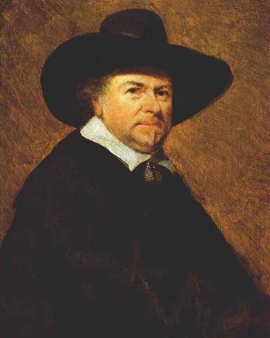


During the "golden age" not only the domestic economy boomed in the Netherlands. In 1650, a good 700 painters were working in what is now Holland, creating an incredible wealth of works of art. As many as 70,000 works of art a year came onto the market. Many of them were exported or were destroyed in the 19th and 20th centuries during wars. Even the names of the artists have often been forgotten in the meantime. Jan van Goyen was spared this fate, even if he did not have much luck in life. The man who is today considered one of the pioneers of Dutch landscape painting was born in Leiden in 1596. His father was a craftsman, his mother a housewife. The fact that despite this modest background he received art lessons at a young age indicates that his great talent was already evident as a child.
From the age of ten he was systematically trained and attended several master schools. As his parents were rather practical, he was initially trained as a glass painter. At that time, glass painting was a respected and lucrative craft. However, Jan was probably made of a different material than the rest of the family and did not want to learn a trade, but to create art. He therefore decided early on to become a landscape painter. For this he moved to Hoorn in the east of the Netherlands, where he was taught by Willem Gerritsz.
This period was followed by an unstable phase in which van Goyen travelled a lot and met his future wife. From 1618 he had to provide for a family and his income as a painter was not sufficient for this. Therefore, he tried his hand at being an art dealer and real estate agent, eventually even as a tulip speculator. What seems to be curious today, was very chic at that time. Tulips were practically the Bitcoins of that era. Economically, however, van Goyen was unsuccessful and died in 1656 in debt in The Hague.
Br/>
Fortunately for posterity, his economic misery did not prevent him from constantly developing as an artist and being enormously productive at the same time. Van der Goyen left behind about 1,200 works. Connoisseurs describe his style as being full of tension; particularly characteristic are perspective diagonals that are played out against the horizontal of the horizon.
Today he is considered the most important representative of tonal landscape painting, alongside Salomon van Ruysdael and Pieter de Molyn. Among his most famous works are the "View of the Merwede near Dordrecht", painted around 1660, the approximately four years younger painting "The Haarlem Sea" and the "Summer by the River", the original of which is shown in the Old Masters Picture Gallery in Dresden.

During the "golden age" not only the domestic economy boomed in the Netherlands. In 1650, a good 700 painters were working in what is now Holland, creating an incredible wealth of works of art. As many as 70,000 works of art a year came onto the market. Many of them were exported or were destroyed in the 19th and 20th centuries during wars. Even the names of the artists have often been forgotten in the meantime. Jan van Goyen was spared this fate, even if he did not have much luck in life. The man who is today considered one of the pioneers of Dutch landscape painting was born in Leiden in 1596. His father was a craftsman, his mother a housewife. The fact that despite this modest background he received art lessons at a young age indicates that his great talent was already evident as a child.
From the age of ten he was systematically trained and attended several master schools. As his parents were rather practical, he was initially trained as a glass painter. At that time, glass painting was a respected and lucrative craft. However, Jan was probably made of a different material than the rest of the family and did not want to learn a trade, but to create art. He therefore decided early on to become a landscape painter. For this he moved to Hoorn in the east of the Netherlands, where he was taught by Willem Gerritsz.
This period was followed by an unstable phase in which van Goyen travelled a lot and met his future wife. From 1618 he had to provide for a family and his income as a painter was not sufficient for this. Therefore, he tried his hand at being an art dealer and real estate agent, eventually even as a tulip speculator. What seems to be curious today, was very chic at that time. Tulips were practically the Bitcoins of that era. Economically, however, van Goyen was unsuccessful and died in 1656 in debt in The Hague.
Br/>
Fortunately for posterity, his economic misery did not prevent him from constantly developing as an artist and being enormously productive at the same time. Van der Goyen left behind about 1,200 works. Connoisseurs describe his style as being full of tension; particularly characteristic are perspective diagonals that are played out against the horizontal of the horizon.
Today he is considered the most important representative of tonal landscape painting, alongside Salomon van Ruysdael and Pieter de Molyn. Among his most famous works are the "View of the Merwede near Dordrecht", painted around 1660, the approximately four years younger painting "The Haarlem Sea" and the "Summer by the River", the original of which is shown in the Old Masters Picture Gallery in Dresden.
Page 1 / 2






